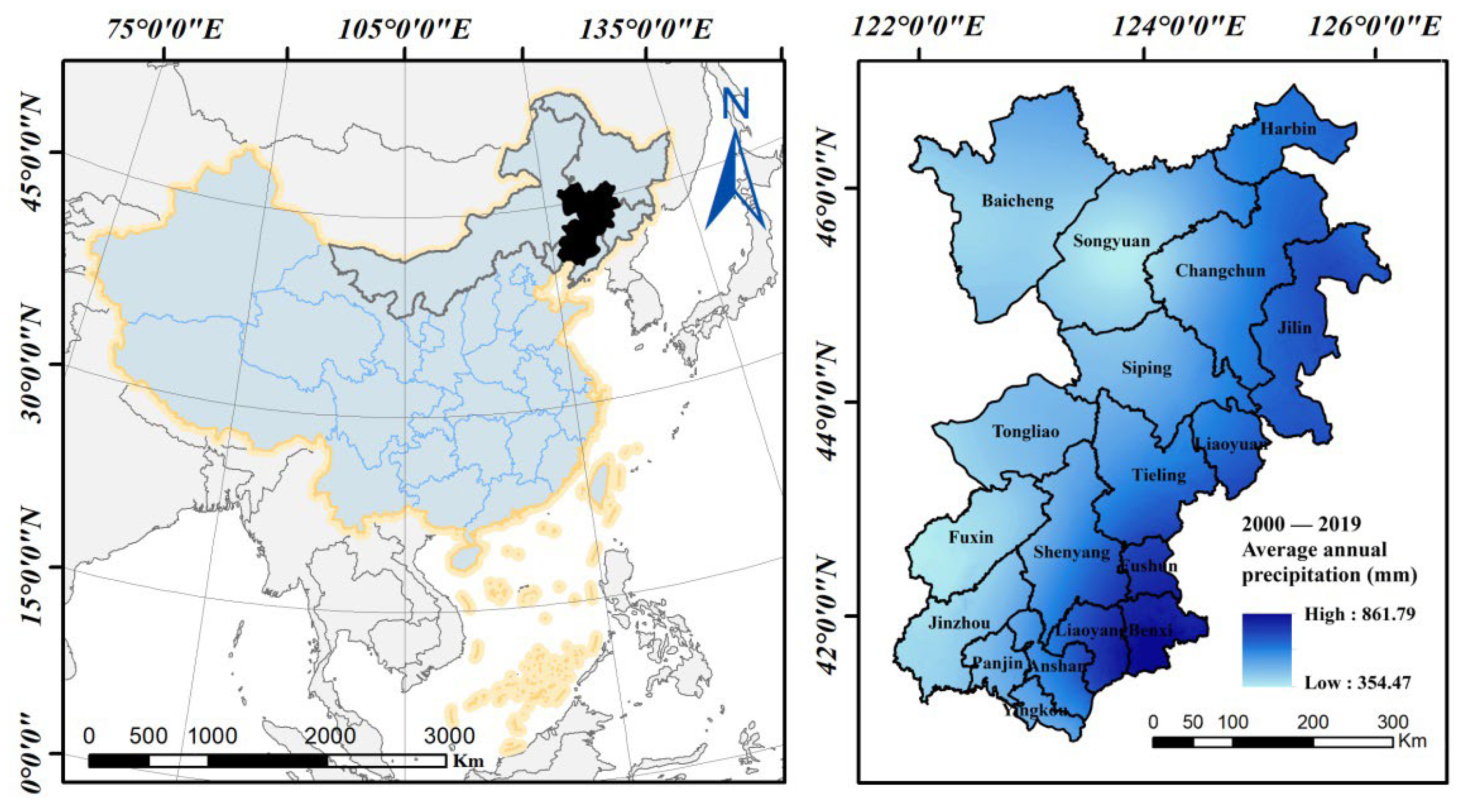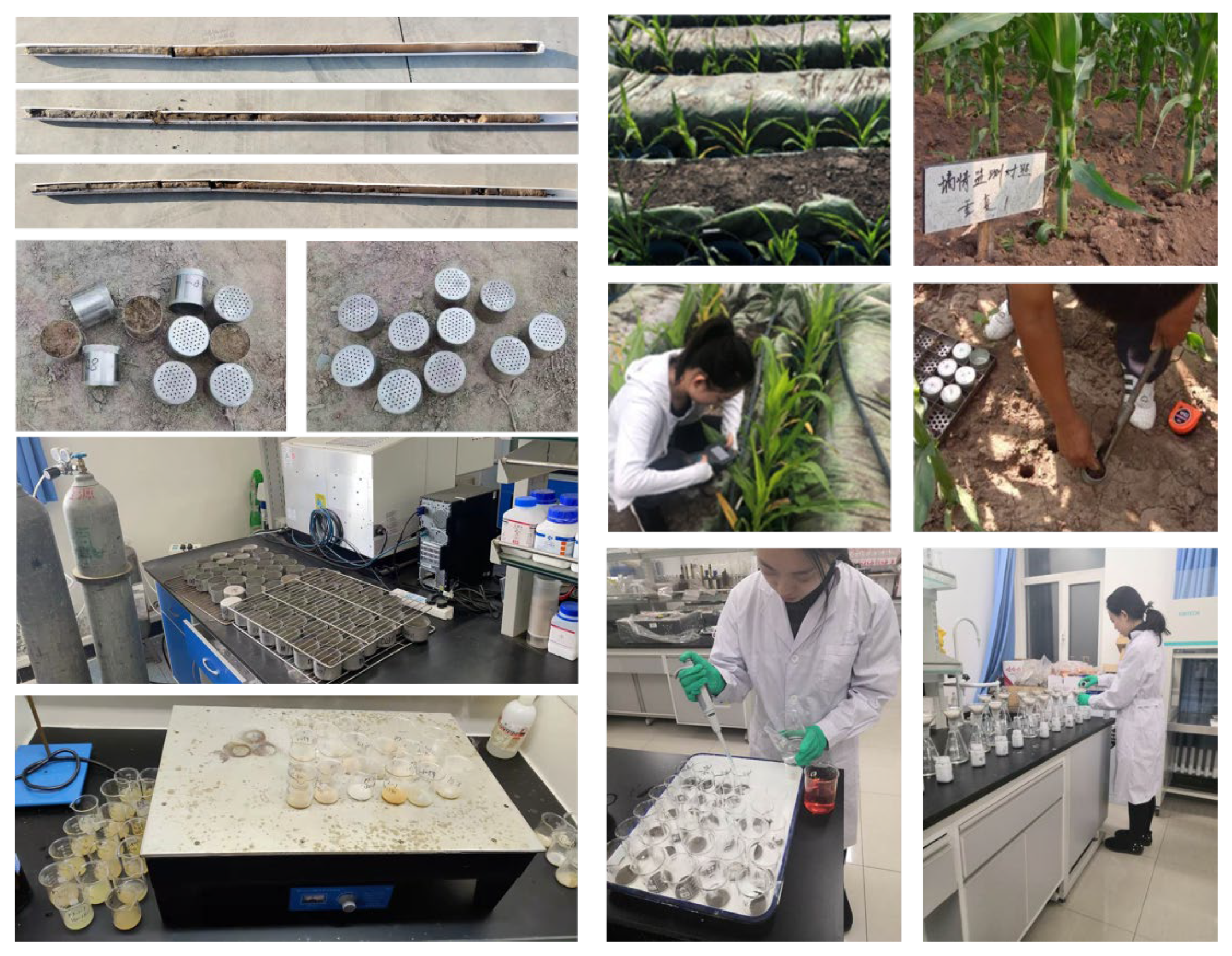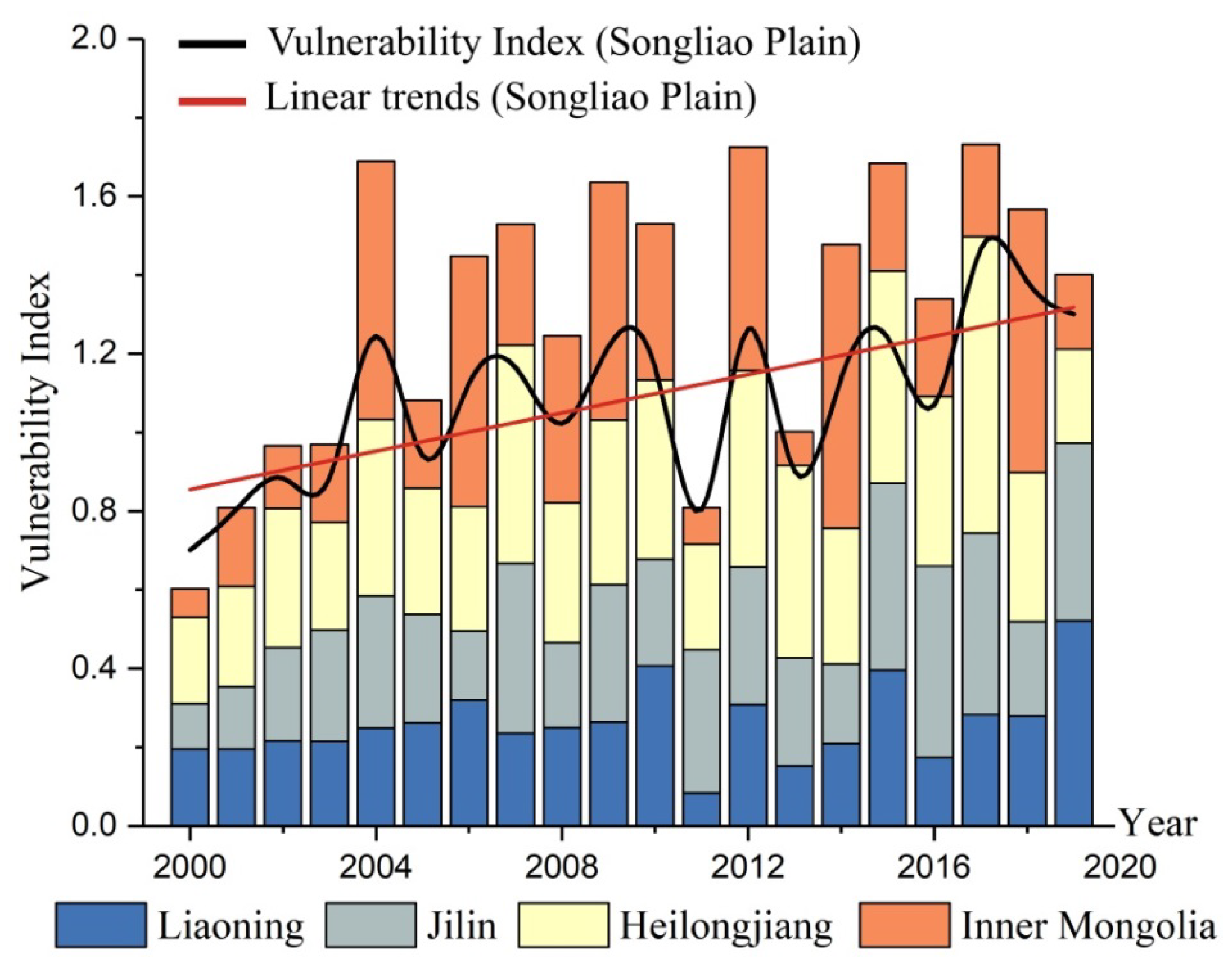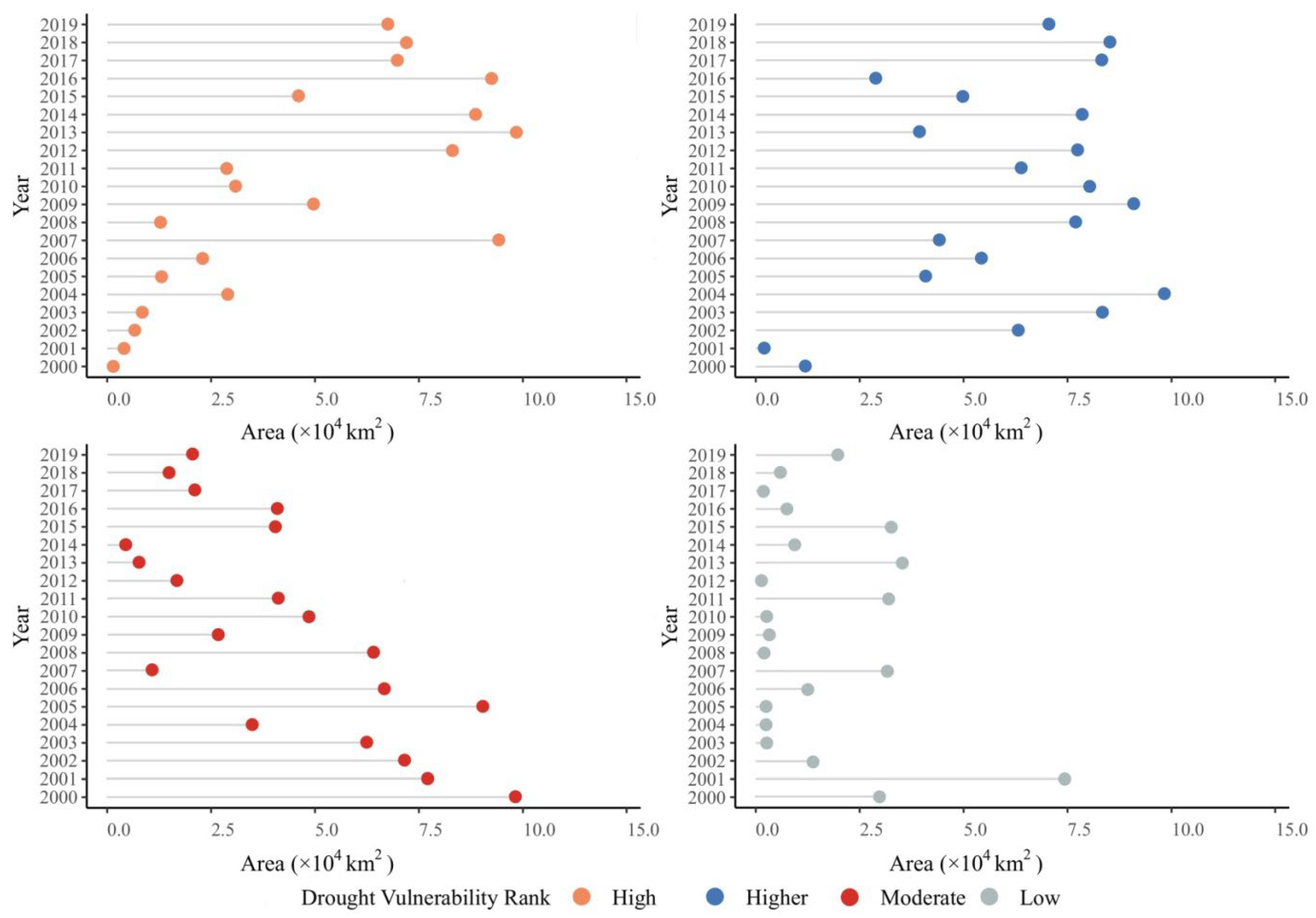Evaluation of Drought Vulnerability of Maize and Influencing Factors in Songliao Plain Based on the SE-DEA-Tobit Model
Abstract
:1. Introduction
2. Materials
2.1. Study Area
2.2. Data Sources
2.2.1. Daily Meteorological Data
2.2.2. Agricultural, Social, Economic, and Drought Disaster Data
2.2.3. Maize Production Data
2.2.4. Soil Data
- (1)
- Soil bulk density ()
- (2)
- Soil wilting moisture ()
- (3)
- Gravimetric water content of soil ()
3. Methodology
3.1. Super-Efficiency DEA Model
3.2. Tobit Model
3.3. Construction of Drought Vulnerability Evaluation Index System of Maize
3.3.1. Input Index
- (1)
- Regional exposure
- (2)
- Drought hazard
3.3.2. Output Index
3.3.3. Disaster Prevention and Mitigation Capacity
- (1)
- The total power of agricultural machinery (kW): this refers to the total power of all kinds of power machinery, which mainly includes all kinds of machinery used in agriculture, forestry, animal husbandry, and fishery.
- (2)
- The proportion of effective irrigated area (%): this refers to the ratio of the effective irrigation area to the total cultivated land area.
- (3)
- The fiscal fund for assisting agriculture (yuan): this refers to all levels of government budget arrangements for the support of agriculture and rural production expenditure, agriculture, forestry and water, and other departments, and it is used to determine the special expenditure funds.
- (4)
- The per capita income of rural households (yuan): this refers to the total income of rural residents in the year from various sources and is used to deduct the sum of consumer spending and savings.
- (5)
- The consumption of chemical fertilizer (tons): this refers to the actual amount of fertilizer used in agricultural production per year.
3.4. Ward Clustering Method
4. Result
4.1. Temporal and Spatial Distribution of Maize Drought Vulnerability in Songliao Plain
4.2. Validation of Evaluation Results
5. Discussion
5.1. Analysis of Influencing Factors of Drought Vulnerability
- (1)
- The coefficient of the total power of agricultural machinery is negative, and its absolute value is relatively large, which indicates that it is more important to reduce the vulnerability to drought. The better developed the power of the agricultural machinery, the higher the level of agricultural modernization and the stronger the ability to reduce drought vulnerability. Mechanized drought resistance can reduce the ineffective evaporation of soil water and promote the rational utilization of water resources.
- (2)
- The proportion of effective irrigated area to vulnerability has a negative effect, and the coefficient estimation is the largest. The results show that emergency preparedness has the greatest impact on maize drought vulnerability among all the influencing factors. Increasing the irrigated area can greatly reduce regional vulnerability and mitigate the adverse effects of drought, thus reducing yield and economic losses.
- (3)
- The fiscal fund for assisting agriculture has a negative effect on drought vulnerability, and by investing in agricultural support, regional vulnerability can be reduced to a large extent, thus reducing the losses caused by drought disasters. Additionally, it also demonstrates the importance that local governments attach to agriculture. Government decision makers will also be more systematic and complete in the formulation of relevant disaster prevention and mitigation policies.
- (4)
- The per capita income of rural households has a relatively small and negative impact on drought vulnerability. This indicates whether residents have the financial capacity to manage a drought. The more economic investment that can be invested in pre-disaster prevention, response, and post-disaster reconstruction, the lower the vulnerability to drought.
- (5)
- The consumption of chemical fertilizer did not pass the 5% significance test, indicating that it had no significant effect on maize drought vulnerability. However, some studies have shown that the proper application of fertilizers can promote the growth of crops at the early stage of growth and enhance their vitality, thus improving their ability to resist adverse environments [60]. However, an excessive application of fertilizers affects soil quality, damages soil physical and chemical properties, and reduces soil productivity, thereby causing damage to crops, or even death [61,62].
5.2. Recommendations for Drought Risk Management in Maize
6. Conclusions
Author Contributions
Funding
Conflicts of Interest
References
- IPCC. Climate Change 2007: The Physical Science Basis. Summary for Policy Makers; IPCC WGI Fourth Report; IPCC: Paris, France, 2007; pp. 195–199. [Google Scholar]
- Ji, F.; Wu, Z.; Huang, J.; Chassignet, E. Evolution of land surface air temperature trend. Nat. Clim. Change 2014, 6, 462–466. [Google Scholar] [CrossRef]
- Paparrizos, S.; Matzarakis, A. Assessment of future climate change impacts on the hydrological regime of selected Greek areas with different climate conditions. Hydrol. Res. 2017, 48, 1327–1342. [Google Scholar] [CrossRef]
- Gao, X.; Shi, Y.; Giorgi, F. A high resolution simulation of climate change over China. Sci. China Earth Sci. 2011, 54, 462–472. [Google Scholar] [CrossRef]
- Bodner, G.; Nakhforoosh, A.; Kaul, H.P. Management of crop water under drought: A review. Agron. Sustain. Dev. 2015, 35, 401–442. [Google Scholar] [CrossRef]
- Wang, Y.; Zhou, B.; Qin, D.; Wu, J.; Gao, R.; Song, L. Changes in mean and extreme temperature and precipitation over the arid region of northwestern China: Observation and projection. Adv. Atmos. Sci. 2017, 34, 289–305. [Google Scholar] [CrossRef]
- Han, L.; Zhang, Q.; Zhang, Z.; Jia, J.; Wang, Y.; Huang, T.; Cheng, Y. Drought area, intensity and frequency changes in China under climate warming, 1961–2014. J. Arid Environ. 2021, 193, 104596. [Google Scholar] [CrossRef]
- Deng, S.; Liu, S.; Mo, X. Assessment and attribution of China’s droughts using an integrated drought index derived from GRACE and GRACE-FO data. J. Hydrol. 2021, 603, 127170. [Google Scholar] [CrossRef]
- Wang, F.; Lai, H.; Li, Y.; Feng, K.; Zhang, Z.; Tian, Q.; Zhu, X.; Yang, H. Dynamic variation of meteorological drought and its relationships with agricultural drought across China. Agric. Water Manag. 2022, 261, 107301. [Google Scholar] [CrossRef]
- Wang, Z.; Xi, L.; Li, Y.; Dong, A. Characteristics of droughts in eastern Northwest China over the past 546 years. Acta. Meteorol. Sin. 2020, 78, 72–85. [Google Scholar]
- Wan, W.; Liu, Z.; Li, J.; Xu, J.; Wu, H.; Xu, Z. Spatiotemporal patterns of maize drought stress and their effects on biomass in the Northeast and North China Plain from 2000 to 2019. Agric. For. Meteorol. 2022, 315, 108821. [Google Scholar] [CrossRef]
- Zhang, Y.; Hao, Z.; Feng, S.; Zhang, X.; Hao, F. Changes and driving factors of compound agricultural droughts and hot events in eastern China. Agric. Water Manag. 2022, 263, 107485. [Google Scholar] [CrossRef]
- Qin, Z.; Tang, H.; Li, W.; Zhang, H.; Zhao, S.; Wang, Q. Modelling impact of agro-drought on grain production in China. Int. J. Disaster Risk Reduct. 2014, 7, 109–121. [Google Scholar] [CrossRef]
- Guo, E.; Liu, X.; Zhang, J.; Wang, Y.; Wang, C.; Wang, R.; Li, D. Assessing spatiotemporal variation of drought and its impact on maize yield in Northeast China. J. Hydrol. 2017, 553, 231–247. [Google Scholar] [CrossRef]
- Piao, S.; Ciais, P.; Huang, Y.; Shen, Z.; Peng, S.; Li, J.; Zhou, L.; Liu, H.; Ma, Y.; Ding, Y.; et al. The impacts of climate change on water resources and agriculture in China. Nature 2010, 467, 43–51. [Google Scholar] [CrossRef]
- IPCC. Climate Change 2013: The Physical Science Basis. Working Group I Contribution to the Fifth Assessment Report of the Intergovernmental Panel on Climate Change; Cambridge University Press: Cambridge, UK, 2013. [Google Scholar]
- Ishtiaque, A.; Estoque, R.C.; Eakin, H.; Parajuli, J.; Rabby, Y.W. IPCC’s current conceptualization of ‘vulnerability’ needs more clarification for climate change vulnerability assessments. J. Environ. Manag. 2022, 303, 114246. [Google Scholar] [CrossRef]
- Ye, T.; Shi, P.; Wang, J.; Liu, L.; Fan, Y.; Hu, J. China’s drought disaster risk management: Perspective of severe droughts in 2009–2010. Int. J. Disaster Risk Sci. 2012, 3, 84–97. [Google Scholar] [CrossRef] [Green Version]
- Chen, W.; Zhang, L. Building vulnerability assessment in seismic areas using ensemble learning: A Nepal case study. J. Clean. Prod. 2022, 350, 131418. [Google Scholar] [CrossRef]
- Van, C.T.; Tuan, N.C.; Son, N.T.; Tri, D.Q.; Anh, L.N.; Tran, D.D. Flood vulnerability assessment and mapping: A case of Ben Hai-Thach Han River basin in Vietnam. Int. J. Disaster Risk. Reduct. 2022, 75, 102969. [Google Scholar] [CrossRef]
- Oikonomou, P.D.; Tsesmelis, D.E.; Waskom, R.M.; Grigg, N.S.; Karavitis, C.A. Enhancing the standardized drought vulnerability index by integrating spatiotemporal information from satellite and in situ data. J. Hydrol. 2019, 569, 265–277. [Google Scholar] [CrossRef]
- Li, Y.; Huang, H.; Ju, H.; Lin, E.; Xiong, W.; Han, X.; Wang, H.; Peng, Z.; Wang, Y.; Xu, J.; et al. Assessing vulnerability and adaptive capacity to potential drought for winter-wheat under the RCP 8.5 scenario in the Huang-Huai-Hai Plain. Agric. Ecosyst. Environ. 2015, 209, 125–131. [Google Scholar] [CrossRef]
- Guo, H.; Wang, R.; Garfin, G.M.; Zhang, A.; Lin, D.; Liang, Q.; Wang, J. Rice drought risk assessment under climate change: Based on physical vulnerability a quantitative assessment method. Sci. Total Environ. 2021, 751, 141481. [Google Scholar] [CrossRef]
- Zhu, X.; Xu, K.; Liu, Y.; Guo, R.; Chen, L. Assessing the vulnerability and risk of maize to drought in China based on the AquaCrop model. Agric. Syst. 2021, 189, 103040. [Google Scholar] [CrossRef]
- Farhangfar, S.; Bannayan, M.; Khazaei, H.R.; Baygi, M.M. Vulnerability assessment of wheat and maize production affected by drought and climate change. Int. J. Disaster Risk Reduct. 2015, 13, 37–51. [Google Scholar] [CrossRef]
- Yildirim, E.; Demir, I. Agricultural flood vulnerability assessment and risk quantification in Iowa. Sci. Total Environ. 2022, 826, 154165. [Google Scholar] [CrossRef]
- Hoque, M.A.; Pradhan, B.; Ahmed, N. Assessing drought vulnerability using geospatial techniques in northwestern part of Bangladesh. Sci. Total Environ. 2020, 705, 135957. [Google Scholar] [CrossRef]
- Ekrami, M.; Marj, A.F.; Barkhordari, J.; Dashtakian, K. Drought vulnerability mapping using AHP method in arid and semiarid areas: A case study for Taft Township, Yazd Province, Iran. Environ. Earth Sci. 2016, 75, 1039. [Google Scholar] [CrossRef]
- Wu, H.; Qian, H.; Chen, J.; Huo, C. Assessment of Agricultural Drought Vulnerability in the Guanzhong Plain, China. Water Resour. Manag. 2017, 31, 1557–1574. [Google Scholar] [CrossRef]
- Hou, J.; Lv, J.; Chen, X.; Yu, S. China’s regional social vulnerability to geological disasters: Evaluation and spatial characteristics analysis. Nat. Hazards 2016, 84, 97–111. [Google Scholar] [CrossRef]
- Fisher, R.A. The statistical utilization of multiple measurements. Ann. Eugen. 1938, 8, 376–386. [Google Scholar] [CrossRef]
- Charnes, A.; Cooper, W.W.; Rhodes, E. Measuring the efficiency of decision making units. Eur. J. Oper. Res. 1978, 2, 429–444. [Google Scholar] [CrossRef]
- Miao, C.; Duan, M.; Sun, X.; Wu, X. Safety management efficiency of China’s coal enterprises and its influencing factors—Based on the DEA-Tobit two-stage model. Process Saf. Environ. 2020, 140, 79–85. [Google Scholar] [CrossRef]
- Dalei, N.N.; Joshi, J.M. Estimating technical efficiency of petroleum refineries using DEA and tobit model: An India perspective. Comput. Chem. Eng. 2020, 142, 107047. [Google Scholar] [CrossRef]
- Huang, X.; Jin, H.; Bai, H. Vulnerability assessment of China’s coastal cities based on DEA cross-efficiency model. Int. J. Disaster Risk Reduct. 2019, 36, 101091. [Google Scholar] [CrossRef]
- Yang, Y.; Guo, H.; Wang, D.; Ke, X.; Li, S.; Huang, S. Flood vulnerability and resilience assessment in China based on super-efficiency DEA and SBM-DEA methods. J. Hydrol. 2021, 600, 126470. [Google Scholar] [CrossRef]
- Yao, L.; Shuai, Y.; Chen, X. Regional water system vulnerability evaluation: A bi-level DEA with multi-followers approach. J. Hydrol. 2020, 589, 125160. [Google Scholar] [CrossRef]
- Wei, Y.; Fan, Y.; Lu, C.; Tsai, H.T. The assessment of vulnerability to natural disasters in China by using the DEA method. Environ. Impact Assess. 2004, 24, 427–439. [Google Scholar] [CrossRef]
- Sahana, V.; Mondal, A.; Sreekumar, P. Drought vulnerability and risk assessment in India: Sensitivity analysis and comparison of aggregation techniques. J. Environ. Manag. 2021, 299, 113689. [Google Scholar] [CrossRef]
- Huang, D.; Zhang, R.; Huo, Z.; Mao, F.; Zheng, Y. An assessment of multidimensional flood vulnerability at the provincial scale in China based on the DEA method. Nat. Hazards 2012, 64, 1575–1586. [Google Scholar] [CrossRef]
- Villano, R.A.; Magcale-Macandog, D.B.; Acosta, L.A.; Tran, C.D.T.T.; Eugenio, E.A.; Macandog, P.B.M. Measuring disaster resilience in the Philippines: Evidence using network data envelopment analysis. Clim. Dev. 2020, 12, 67–79. [Google Scholar] [CrossRef]
- Li, C.; Li, N.; Wu, L.; Hu, A. A relative vulnerability estimation of flood disaster using data envelopment analysis in the Dongting Lake region of Hunan. Nat. Hazards Earth. Syst. 2013, 13, 1723–1734. [Google Scholar] [CrossRef]
- Zhou, W. A Study on Available Water Capacity of Main Soil Types in China Based on Geographic Information System; Nanjing Agricultural University: Nanjing, China, 2003. (In Chinese) [Google Scholar]
- Zhou, W. Empirical estimation of effective soil water content in black soils of Northeast China. J. Arid. Land Resour. Environ. 2003, 4, 88–95. (In Chinese) [Google Scholar]
- Xue, M.; Harker, P.T. Note: Ranking DMUs with infeasible super-efficiency DEA methods. Manag. Sci. 2002, 48, 705–707. [Google Scholar] [CrossRef] [Green Version]
- Banker, R.D.; Charnes, A.; Cooper, W.W. Models for the estimation of technical and scale inefficiencies in DEA. Manag. Sci. 1984, 30, 1078–1092. [Google Scholar] [CrossRef] [Green Version]
- Su, S.; Zhang, F. Modeling the role of environmental regulations in regional green economy efficiency of China: Empirical evidence from super efficiency DEA-Tobit model. J. Environ. Manag. 2020, 261, 110227. [Google Scholar] [CrossRef]
- Tobin, J. Estimation of Relationships for Limited Dependent Variables. Econometrica 1958, 26, 24–36. [Google Scholar] [CrossRef] [Green Version]
- Albertini, F.; Gomes, L.P.; Grondona, A.E.B.; Caetano, M.O. Assessment of environmental performance in building construction sites: Data envelopment analysis and Tobit model approach. J. Build. Eng. 2021, 44, 102994. [Google Scholar] [CrossRef]
- Ma, Y.; Zhang, J.; Zhao, C.; Li, K.; Dong, S.; Liu, X.; Tong, Z. Spatiotemporal Variation of Water Supply and Demand Balance under Drought Risk and Its Relationship with Maize Yield: A Case Study in Midwestern Jilin Province, China. Water 2021, 13, 2490. [Google Scholar] [CrossRef]
- Gao, C.; Chen, C.; He, Y.; Ruan, T.; Luo, G.; Sun, Y. Response of Agricultural Drought to Meteorological Drought: A Case Study of the Winter Wheat above the Bengbu Sluice in the Huaihe River Basin, China. Water 2020, 12, 2805. [Google Scholar] [CrossRef]
- Tian, Q.; Lu, J.; Chen, X. A novel comprehensive agricultural drought index reflecting time lag of soil moisture to meteorology: A case study in the Yangtze River basin, China. Catena 2022, 209, 105804. [Google Scholar] [CrossRef]
- Ma, Y.; Guga, S.; Xu, J.; Liu, X.; Tong, Z.; Zhang, J. Assessment of Maize Drought Risk in Midwestern Jilin Province: A Comparative Analysis of TOPSIS and VIKOR Models. Remote Sens. 2022, 14, 2399. [Google Scholar] [CrossRef]
- Allen, R.G.; Pereira, L.S.; Raes, D.; Smith, M. Crop Evapotranspiration: Guidelines for Computing Crop Water Requirements; FAO: Rome, Italy, 1998. [Google Scholar]
- Chu, R.; Li, M.; Shen, S.; Islam, A.R.M.T.; Cao, W.; Tao, S.; Gao, P. Changes in reference evapotranspiration and its contributing factors in Jiangsu, a major economic and agricultural province of eastern China. Water 2017, 9, 486. [Google Scholar] [CrossRef] [Green Version]
- Jhajharia, D.; Dinpashoh, Y.; Kahya, E.; Singh, V.P.; Fard, A.F. Trends in reference evapotranspiration in the humid region of northeast India. J. Hydrol. 2012, 26, 421–435. [Google Scholar] [CrossRef]
- Zhang, Y.; Wang, Y.; Niu, H. Effects of temperature, precipitation and carbon dioxide concentrations on the requirements for crop irrigation water in China under future climate scenarios. Sci. Total Environ. 2019, 656, 373–387. [Google Scholar] [CrossRef]
- Ma, Y.; Guga, S.; Xu, J.; Zhang, J.; Tong, Z.; Liu, X. Comprehensive Risk Assessment of High Temperature Disaster to Kiwifruit in Shaanxi Province, China. Int. J. Environ. Res. Public Health 2021, 18, 10437. [Google Scholar] [CrossRef]
- Ward, J.H., Jr. Hierarchical grouping to optimize an objective function. J. Am. Stat. Assoc. 1963, 58, 236–244. [Google Scholar] [CrossRef]
- Tilman, D.; Balzer, C.; Hill, J.; Befort, B.L. Global food demand and the sustainable intensification of agriculture. Proc. Natl. Acad. Sci. USA 2011, 108, 20260–20264. [Google Scholar] [CrossRef] [Green Version]
- Choruma, D.J.; Balkovic, J.; Pietsch, S.A.; Odume, O.N. Using EPIC to simulate the effects of different irrigation and fertilizer levels on maize yield in the Eastern Cape, South Africa. Agric. Water Manag. 2021, 254, 106974. [Google Scholar] [CrossRef]
- Grinsven, H.J.M.V.; Holland, M.; Jacobsen, B.H.; Klimont, Z.; Sutton, M.A.; Willems, W.J. Costs and benefits of nitrogen for Europe and implications for mitigation. Environ. Sci. Technol. 2013, 47, 3571–3579. [Google Scholar] [CrossRef] [PubMed]
- Domínguez, A.; Juan, J.A.; Tarjuelo, J.M.; Martínez, R.S.; Martínez-Romero, A. Determination of optimal regulated deficit irrigation strategies for maize in a semi-arid environment. Agric. Water Manag. 2012, 110, 67–77. [Google Scholar] [CrossRef]
- Zou, Y.; Saddique, Q.; Ali, A.; Xu, J.; Khan, M.I.; Qing, M.; Azmat, M.; Cai, H.; Siddique, K.H.M. Deficit irrigation improves maize yield and water use efficiency in a semi-arid environment. Agric. Water Manag. 2021, 243, 106483. [Google Scholar] [CrossRef]
- Kang, S.; Shi, W.; Zhang, J. An improved water-use efficiency for maize grown under regulated deficit irrigation. Field Crops Res. 2000, 67, 207–214. [Google Scholar] [CrossRef]
- Fereres, E.; Soriano, M.A. Deficit irrigation for reducing agricultural water use. J. Exp. Bot. 2007, 58, 147–159. [Google Scholar] [CrossRef] [Green Version]
- Zhang, F.; Chen, Y.; Zhang, J.; Guo, E.; Wang, R.; Li, D. Dynamic drought risk assessment for maize based on crop simulation model and multi-source drought indices. J. Clean. Prod. 2019, 233, 100–114. [Google Scholar] [CrossRef]
- Bolanos, J.; Edmeades, G. The importance of the anthesis-silking interval in breeding for drought tolerance in tropical maize. Field Crops Res. 1996, 48, 65–80. [Google Scholar] [CrossRef]
- NeSmith, D.; Ritchie, J. Effects of soil water-deficits during tassel emergence on development and yield component of maize (Zea mays). Field Crop. Res. 1992, 28, 251–256. [Google Scholar] [CrossRef]
- Saini, H.S.; Westgate, M.E. Reproductive development in grain crops during drought. Adv. Agron. 2000, 68, 59–96. [Google Scholar] [CrossRef]
- Çakir, R. Effect of water stress at different development stages on vegetative and reproductive growth of corn. Field Crops Res. 2004, 89, 1–16. [Google Scholar] [CrossRef]









| Year | Period of Drought | Damage Caused by Drought |
|---|---|---|
| 2003 | May–June | Heilongjiang Province suffered from a severe drought, which affected a large area, severely reduced grain production, and caused an economic loss of more than 2.27 × 106 yuan. |
| 2007 | June–August | In Liaoning Province, 55% of the arable land was affected by drought, with economic losses of 4.39 × 106 yuan. The drought-affected area in Jilin Province accounts for 77.6% of the crop sown area. |
| 2011 | January–March | Northern Heilongjiang and central Jilin suffered from a rare winter–spring drought. |
| 2015 | June | In Liaoning Province, 6.78 × 106 people were affected by drought, with 1.43 × 106 hm2 of crops affected and 2.33 × 105 hm2 of crops lost, resulting in a direct economic loss of 6.08 × 106 yuan. |
| July | In Liaoyuan, Baicheng, Jilin, and Tonghua, 4.02 × 106 people were affected, with 7.0 × 107 hm2 of crops affected and a direct economic loss of 7.36 × 106 yuan. In Dongfeng county, 1.82 × 107 people were affected, with 5.2 × 104 hm2 of crops affected and a direct economic loss of 2.9 × 108 yuan. | |
| July–August | In Tongliao city, Inner Mongolia, 1.78 × 105 people were affected, with 1.17 × 105 hm2 of crops and 1.8 × 105 hm2 of grassland affected, resulting in a direct economic loss of 4.4 × 108 yuan. | |
| 2019 | May–August | In Jilin Province, 1.25 × 106 hm2 were affected by drought, and 0.4 × 106 hm2 were not harvested, especially in the central region. In early May, some areas in western Liaoning experienced a severe drought, which prevented spring sowing. From the beginning of July, Dalian and Yingkou had different degrees of meteorological drought. Most areas had severe drought, and some areas of Dalian had reached the level of special drought. |
| Variable | Average | Maximum | Minimum | Standard Deviation |
|---|---|---|---|---|
| Total power of agricultural machinery (×106 kW) | 5.36 | 11.49 | 1.43 | 2.02 |
| Proportion of effective irrigated area (%) | 37.22 | 72.01 | 10.11 | 17.69 |
| Fiscal fund for assisting agriculture (×108 yuan) | 47.76 | 114.59 | 11.59 | 27.54 |
| Per capita income of rural households (×104 yuan) | 1.58 | 1.89 | 1.12 | 0.2 |
| Consumption of chemical fertilizer (×104 tons) | 33.68 | 100.66 | 1.2 | 28.16 |
| Variable | Coefficient Estimate | Standard Deviation | Z Value | p Value |
|---|---|---|---|---|
| Constant (C) | 0.119 | 0.149 | 0.8 | 0.0000 |
| Total power of agricultural machinery (X1) | −0.321 | 0.26 | −0.082 | 0.0025 |
| Proportion of effective irrigated area (X2) | −0.672 | 0.193 | 2.45 | 0.0038 |
| Fiscal fund for assisting agriculture (X3) | −0.217 | 0.288 | −0.405 | 0.0102 |
| Per capita income of rural households (X4) | −0.189 | 0.221 | −0.362 | 0.0255 |
| Consumption of chemical fertilizer (X5) | 0.19 | 0.28 | 0.68 | 0.5100 |
Publisher’s Note: MDPI stays neutral with regard to jurisdictional claims in published maps and institutional affiliations. |
© 2022 by the authors. Licensee MDPI, Basel, Switzerland. This article is an open access article distributed under the terms and conditions of the Creative Commons Attribution (CC BY) license (https://creativecommons.org/licenses/by/4.0/).
Share and Cite
Ma, Y.; Guga, S.; Xu, J.; Liu, X.; Tong, Z.; Zhang, J. Evaluation of Drought Vulnerability of Maize and Influencing Factors in Songliao Plain Based on the SE-DEA-Tobit Model. Remote Sens. 2022, 14, 3711. https://doi.org/10.3390/rs14153711
Ma Y, Guga S, Xu J, Liu X, Tong Z, Zhang J. Evaluation of Drought Vulnerability of Maize and Influencing Factors in Songliao Plain Based on the SE-DEA-Tobit Model. Remote Sensing. 2022; 14(15):3711. https://doi.org/10.3390/rs14153711
Chicago/Turabian StyleMa, Yining, Suri Guga, Jie Xu, Xingpeng Liu, Zhijun Tong, and Jiquan Zhang. 2022. "Evaluation of Drought Vulnerability of Maize and Influencing Factors in Songliao Plain Based on the SE-DEA-Tobit Model" Remote Sensing 14, no. 15: 3711. https://doi.org/10.3390/rs14153711
APA StyleMa, Y., Guga, S., Xu, J., Liu, X., Tong, Z., & Zhang, J. (2022). Evaluation of Drought Vulnerability of Maize and Influencing Factors in Songliao Plain Based on the SE-DEA-Tobit Model. Remote Sensing, 14(15), 3711. https://doi.org/10.3390/rs14153711









